Cheek Augmentation
Cheek augmentation is a cosmetic procedure that enhances and reshapes the midface and cheek area. The midface is often one of the first regions to show visible signs of age-related volume loss, resulting in a sunken or hollow appearance. Historically, the only options for achieving a midface lift in your cheeks were cheek implants or a facial fat transfer. However, thanks to advances in dermal fillers, invasive surgical procedures are now often unnecessary. Non-invasive treatments with dermal fillers are leading in cosmetic dermatology, offering patients a simple, safe, and quick way to restore volume and diminish fine lines in the midface, jowls, lips, under-eye area, and jawline. For those seeking a natural, youthful volume and contour without undergoing plastic surgery, Dr. Green in NYC provides a variety of facial filler treatments to revitalize the midface and help achieve a more youthful appearance.
Many patients prefer dermal fillers over cheek implants or fat transfers for cheek augmentation because they can restore volume, improve facial definition and contour, and diminish the appearance of hollows, fine lines, and wrinkles without any downtime or discomfort. Unlike surgical options, cheek fillers involve minimal recovery time and side effects, making it convenient for patients with busy schedules to achieve their desired look. If your cheeks have lost volume due to aging or genetics, or if you feel self-conscious about a flat or “tired” appearance, cheek augmentation with dermal fillers and Dr. Green may be the right choice for you.
Dr. Michele Green is an internationally acclaimed, board-certified dermatologist with over 25 years of experience providing some of the world’s most discerning individuals with the best non-invasive cosmetic procedures, including dermal filler injections for cheek augmentation. Dr. Green adopts a holistic approach and follows a less-is-more philosophy for facial rejuvenation, tailoring each patient’s treatment plan to effectively address their specific concerns and achieve their ideal aesthetic goals. She is consistently recognized by Castle Connolly, Super Doctors, New York Magazine, and The New York Times as one of New York City’s top dermatologists for her dedication and expertise. When you schedule a consultation with Dr. Green at her private dermatology practice in Manhattan’s Upper East Side, she will collaborate with you to develop a personalized treatment plan that rejuvenates and highlights your unique facial features, delivering exceptional, long-lasting, natural-looking results.
What is cheek augmentation?
Cheek augmentation is a cosmetic procedure that enhances the cheeks by adding volume or creating contour. Patients seek cheek augmentation to restore lost facial volume and achieve contoured cheekbones for a more youthful midface appearance. Some also pursue it for increased facial harmony, aiming for high, sculpted cheekbones for a refined look. Whether you experience age-related volume loss or naturally have a hollow mid-face, achieving high cheekbones and a sleek, contoured look is possible with cheek augmentation. This procedure should always be performed in a medical setting by a board-certified plastic surgeon or dermatologist, such as Dr. Michele Green in New York City. With over 25 years of experience, Dr. Green expertly provides cosmetic injectables for facial rejuvenation, including cheek augmentation. During a consultation at her discreet NYC office, you’ll learn more about the process and options for cheek augmentation.
What does cheek augmentation do?
Cheek augmentation aims to address facial volume loss and hollowness while enhancing your natural facial shape, restoring the youthful beauty of your cheekbones. As we age, collagen and elastin levels decline—two essential proteins that support the skin’s structure and help maintain a supple, youthful look. The loss of collagen and elastin in the cheek area can lead to loose skin, volume loss, wrinkles, and hollows under the eyes, making us appear much older than we feel. Cheek augmentation restores midface volume, helping correct these issues and create fuller cheeks and a more youthful appearance.
Two common procedures for cheek augmentation are cheek implants and facial fat transfer. Cheek implants are inserted into the midface to rebuild structure and enhance cheek prominence permanently. A fat transfer involves removing fat from another part of the body and injecting it into the cheeks to restore volume. Non-invasive procedures for cheek augmentation include dermal fillers such as Juvederm, Restylane, Sculptra, and Radiesse, which help replace lost volume and achieve a youthful, natural look without surgery or downtime.
What is cheek augmentation surgery?
Cheek augmentation surgery is an outpatient procedure that restores volume and enhances facial structure and definition. It should be performed only by a board-certified facial plastic surgeon in a medical setting to ensure safe and effective results. The two main surgical options for cheek augmentation are cheek implants and fat transfer. In some cases, a plastic surgeon may perform cheek implants or facial fat transfers along with a facelift to achieve the best results.
Cheek implants
Cheek implants are solid devices placed under the skin to change the shape of the cheeks and cheekbones permanently. These implants come in various materials, including solid silicone, porous polyethylene (Medpor), or hydroxyapatite (a mix of enamel and bone). Depending on your bone structure and aesthetic goals, the plastic surgeon may use malar implants to create the appearance of more prominent cheekbones, or submalar implants, which go beneath the cheekbones to add fullness and restore volume. The surgeon can also combine both malar and submalar implants for maximum cheek enhancement. Usually, the implants are inserted through small incisions inside the mouth or near the lower eyelid, depending on the implant type and accessibility. Implants may be sculpted to correct facial asymmetry or used in reconstructive surgery. Typically, a general anesthetic is used to complete the procedure.
Facial fat transfer
A facial fat transfer, also known as fat grafting, is a surgical procedure that involves removing fat from one area of the body and injecting it into the face to add volume. To address volume loss from aging, this procedure uses liposuction, or surgical fat removal, to remove stubborn fat deposits from areas such as the stomach, thighs, or buttocks. The harvested fat cells are then purified and injected into the cheeks. This cosmetic surgery usually takes about two to three hours, with patients typically under general anesthesia. It offers a semi-permanent solution for restoring facial volume, with results lasting several years; however, some of the injected fat may gradually diminish over time.
What are cheek fillers?
Cheek fillers are dermal fillers designed specifically for injections into the cheeks and midface to restore volume, diminish fine lines and wrinkles, improve acne scars, and enhance facial features. Although many different types of fillers are available on the market, the most popular cheek fillers are made of hyaluronic acid, poly-L-lactic acid, or calcium hydroxylapatite. Hyaluronic acid (HA) is a naturally occurring substance in the body that supplies essential hydration to the skin for plumpness and smoothness. Poly-L-lactic acid (PLLA) and calcium hydroxylapatite (CaHA) are two compounds that stimulate new collagen production after injection, resulting in smoother skin texture and restored volume in the treated area. HA fillers provide immediate results, while PLLA and CaHA fillers require a series of initial treatments to reach optimal effectiveness. Once injected, cheek fillers offer long-lasting results that can last between one and two years, depending on the specific filler used.
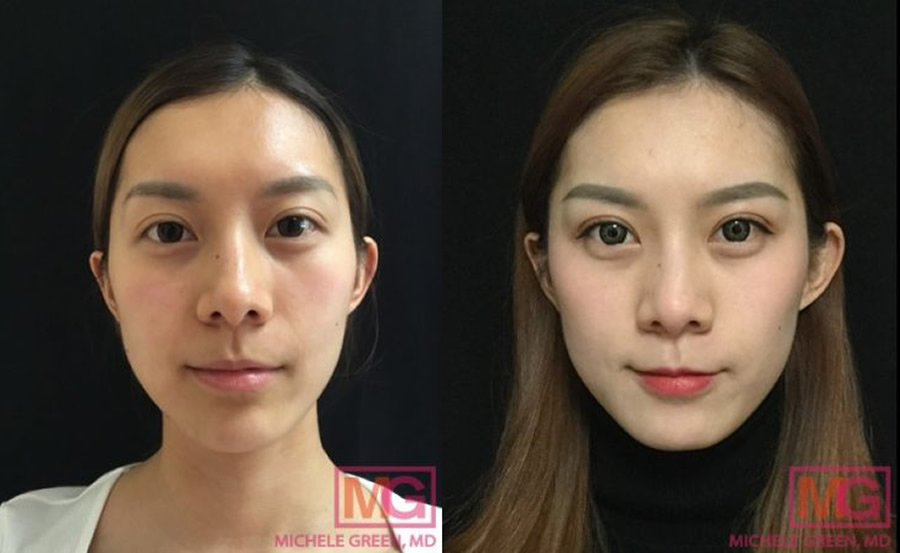
Sculptra Before and after – 3 months
Which fillers are used for cheek augmentation?
Certain dermal fillers are customized to enhance the appearance of the cheek area and midface. Each filler has different properties and formulations to meet various skin needs. Dr. Green will consider each patient’s unique concerns and aesthetic goals to select the best cheek filler that delivers their desired results. The following are among the most popular dermal fillers for cheek enhancement.
- Juvederm Voluma: Juvederm Voluma is a hyaluronic acid dermal filler created to restore youthful facial volume and diminish various signs of aging in the cheeks and chin. This filler uses Allergan’s innovative Vycross technology, enabling it to provide a significant lifting effect with exceptional longevity. Juvederm Voluma is among the thickest fillers in the Juvederm line and can last for 12 months or longer.
- Sculptra: Sculptra contains poly-L-lactic acid, a compound that promotes the production of new collagen in the treatment area. By restoring collagen levels in the treated areas, Sculptra can add volume and contour, and improve the appearance of facial volume loss, fine lines, mild skin laxity, and acne scars. Sculptra can last for two years or more after a series of initial treatments.
- Restylane Lyft: This hyaluronic acid filler is formulated to restore volume in the midface, diminish the appearance of deep nasolabial folds and wrinkles around the mouth, and rejuvenate the look of the hands. Restylane Lyft can last up to one year in the treated area.
- Restylane Contour: This hyaluronic acid filler, also from the Restylane family, is designed to add fullness to the cheeks, improve skin elasticity, and define facial contours and enhance cheekbone prominence. Restylane Contour uses proprietary XpresHAn technology to carefully blend hyaluronic acid with the skin cells at or near the injection site, creating a smooth result that doesn’t block natural facial expressions and movement. Restylane Contour can last up to 12 months.
- Radiesse: This calcium hydroxyapatite-based filler helps restore lost collagen beneath your skin. Using patented microsphere technology, each injection initiates a process called collagenesis, which encourages your body to produce new collagen and promotes collagen growth around the injection site. Simultaneously, the CaHA gel microspheres provide immediate volume, filling in visible deep lines and wrinkles. After an initial series of treatments, Radiesse can last for up to one year.
Which is better for cheek augmentation: surgical procedures or non-invasive dermal fillers?
Cheek augmentation procedures have gained popularity recently because they provide an elegant, non-surgical way to restore facial volume, address sagging skin, and replace natural collagen lost with age. In the past, facial plastic surgery with cheek implants or fat transfers was the primary method for achieving fuller cheeks. However, long recovery times, bruising, sedation, sutures, and limited mobility after surgery have led dermatologists and patients to prefer non-invasive options, such as cheek enhancement with dermal fillers like Juvederm, Restylane, Sculptra, and Radiesse. These fillers are injected into soft tissue and deliver long-lasting, natural-looking results, offering an effective solution for those seeking to enhance cheekbone prominence or restore midface volume without invasive surgery or downtime.
Patients appreciate the semi-permanent nature of dermal fillers, which allows them to adjust their cheek enhancement plan at each session to meet their evolving cosmetic goals. Dermal fillers typically last one to two years, depending on the type used. To determine the best cheek augmentation procedure for you, it’s advisable to consult an experienced and knowledgeable medical professional, such as board-certified dermatologist Dr. Michele Green. With over twenty years of experience in treating facial volume loss, shaping facial contours, and achieving a natural-looking, more youthful appearance, Dr. Green can help you find the most effective solution. To ensure safe and satisfactory results, schedule a consultation with Dr. Green in New York City. She can help tailor a treatment plan and create a timeline for facial rejuvenation that addresses your skin concerns and cosmetic goals, all without the need for invasive surgery or downtime.
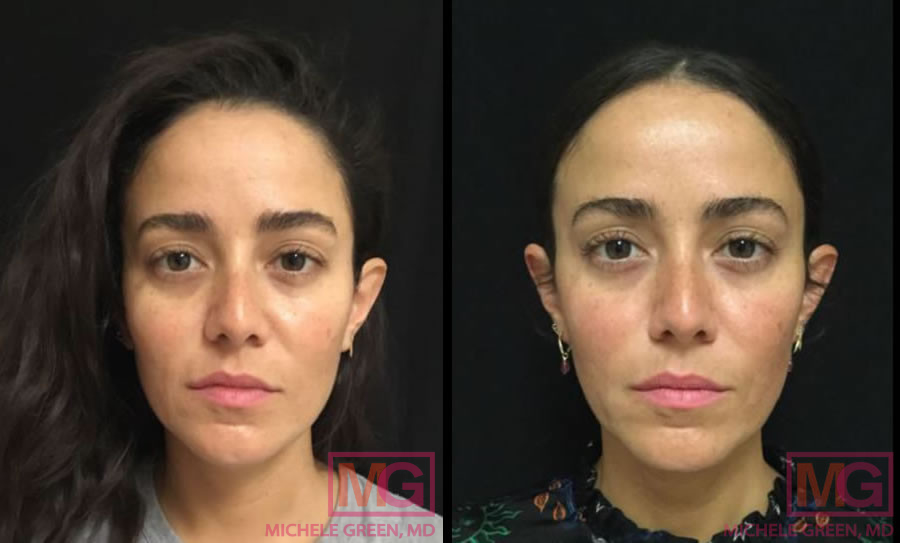
3 weeks Before and After – Juvederm Voluma
Who is a good candidate for non-invasive cheek augmentation with dermal fillers?
A suitable candidate for non-invasive cheek augmentation is any patient over 21 who is generally healthy, desires more volume or contour in the midface, and has realistic expectations for their cosmetic cheek enhancement. Patients may not be suitable for dermal fillers if they have a history of severe allergic reactions, keloids, hypertrophic scarring, or allergies to lidocaine or other filler ingredients. Those with an active infection, acne breakout, or rash in the treatment area should wait until the skin condition improves to lower the risk of aggravating it. Additionally, pregnant or breastfeeding women should avoid dermal filler injections, as their safety has not yet been confirmed. The best way to determine if you are a good candidate is to consult a board-certified dermatologist, such as Dr. Green. When you meet with Dr. Green at her private dermatology office in Manhattan’s Upper East Side, she will review your medical and family history, evaluate your facial anatomy, and discuss your concerns and goals to see if dermal fillers for cheek augmentation are appropriate for you.
What is the cheek augmentation procedure like with dermal fillers?
The first step to achieving cheek augmentation with injectable fillers is scheduling a consultation with Dr. Michele Green at her private dermatology office in the Upper East Side. During the consultation, you will discuss your medical history, previous cosmetic procedures (including any injections), and your desired results with Dr. Green. Medical photographs will be taken to support the discussion and monitor your treatment progress. Together with Dr. Green, you will create a treatment plan and timeline that addresses your skin concerns and aesthetic goals. Once the specific procedures are decided, you can have your treatment either on the day of your consultation or schedule it for a later date, based on your preference and availability.
Before coming to the office for cosmetic dermal filler injections, Dr. Green recommends stopping any blood-thinning medications or vitamins, including aspirin, garlic, multivitamins, vitamin E, and fish oil, for two weeks prior. These medications can increase the risk of bruising as a side effect of dermal filler injections. If you tend to bruise easily, over-the-counter Arnika Forte, an herbal supplement, can be taken several days before your treatment to help reduce bruising and swelling.
One hour before your injections, apply a topical numbing cream to the entire treatment area to reduce discomfort. When you arrive for your appointment, your numbing cream will be removed, and your skin will be sterilized. Dr. Green will then perform your cheek augmentation injections. The treatment area will be iced immediately after the procedure to help minimize any swelling. Dr. Green will review relevant aftercare instructions with you and schedule a follow-up appointment in two weeks to assess your results and determine if any touch-up is necessary.
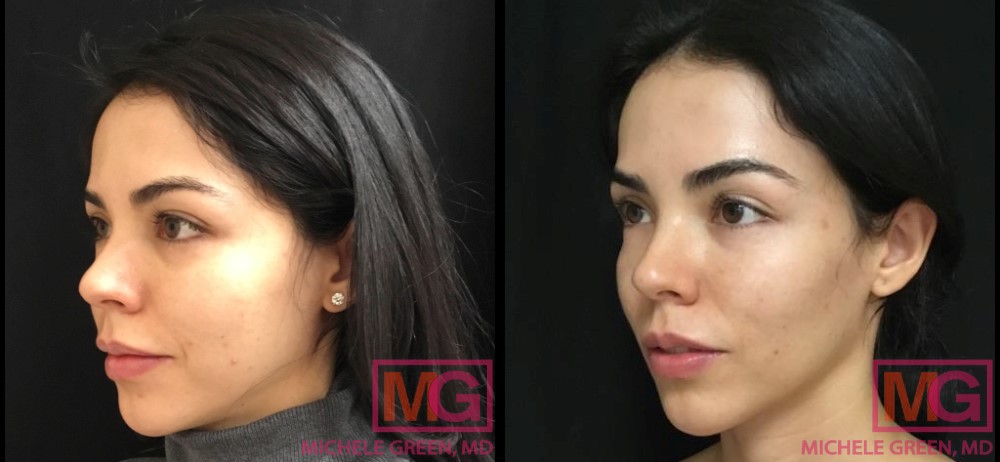
Juvederm Voluma in the cheeks. Two syringes.
How long is the downtime for cheek fillers?
Unlike invasive plastic surgery procedures for cheek augmentation, cheek fillers have no downtime, and most patients can resume their daily activities immediately. It is expected that mild swelling, redness, and bruising will resolve on their own within 1 to 2 weeks of treatment. Patients should avoid strenuous activities, hot tubs, and steam saunas for at least 48 hours after cheek filler treatment, as this could worsen any swelling. For patients prone to bruising or who bruise after the procedure, Arnika Forte can be taken for several days to help prevent bruising or speed healing. Recovery after dermal filler injections for cheek augmentation is minimal, making them a convenient and effective option.
What are the side effects of cheek filler injections?
For most patients, the side effects of dermal filler cheek augmentation are very mild, if they occur at all. Possible side effects may include minor swelling, redness, tenderness, or bruising at the injection site, which typically resolve quickly after treatment. In rare cases, serious side effects like an infection or filler being injected into a blood vessel can happen. However, these severe complications are much more likely to occur with an unskilled or unqualified injector, such as those working at medical spas or aesthetic centers. Therefore, it is always best to schedule a consultation with an experienced, board-certified dermatologist, such as Dr. Green, to ensure safe and effective cheek filler results.
How long does cheek augmentation last with dermal fillers?
On average, cheek fillers provide results that last between one and two years. The type of fillers used mainly determines how long the results last. Hyaluronic acid fillers like Juvederm Voluma, Restylane Lyft, and Restylane Contour offer immediate results and last around 12 months. Radiesse can last up to a year after initial treatments, while Sculptra can last two or more years after the first treatments. Many patients schedule regular maintenance sessions to maintain and improve their results. When you consult with board-certified dermatologist Dr. Michele Green at her private NYC office, she will help you create a treatment plan that fits your specific needs and goals.
Are cheek fillers safe?
Yes! Cheek fillers are a safe and effective non-surgical cosmetic option for facial rejuvenation. Juvederm Voluma, Sculptra, Restylane Lyft, Restylane Contour, and Radiesse are all FDA-approved for cheek augmentation, demonstrating their safety and effectiveness through numerous clinical trials. The most common side effects of cheek fillers include mild redness, swelling, and bruising, which usually resolve shortly after treatment. Cheek fillers are a great alternative to cheek implants or facial fat transfers, which can involve long recovery times, incisions, and higher risks due to anesthesia. Dr. Green is a board-certified dermatologist with over 25 years of experience, providing her patients with top-quality non-surgical cosmetic procedures for beautiful, natural-looking, long-lasting facial rejuvenation. When you choose to work with an expert injector like Dr. Green, you ensure that your dermal filler treatment emphasizes patient safety and satisfaction.
Frequently Asked Questions (FAQs) about Cheek Augmentation
Can cheek augmentation fix which cheek is bigger?
Yes! One reason why patients undergo cheek augmentation procedures is to correct facial asymmetry. Some individuals may have facial asymmetry due to genetics, while others might develop it from lifestyle habits, trauma, or medical conditions. Cheek augmentation can be customized for each person to meet their specific needs, resulting in a natural-looking, more balanced appearance.
Who should get cheek augmentation?
The decision to undergo a cheek augmentation procedure is personal for each patient. For some, the desire for increased facial harmony or symmetry might be the main reason, as cheek augmentation can shape high, elegant, contoured cheekbones. For others, age-related volume loss might be the key factor. As we age, collagen production decreases, leading to loose, sagging skin and reduced midface volume. Dermal filler cheek augmentation can restore lost volume in the cheeks and under the eyes for a more youthful look. If you’re interested in cheek augmentation, start by booking a consultation with the board-certified dermatologist, Dr. Green.
Is cheek augmentation permanent?
Cheek augmentation can be permanent, depending on the procedure used. Cheek implants are permanent once inserted, but can be removed with another surgical procedure if the cosmetic results are unwanted. Facial fat transfer is considered permanent, although the body can gradually reabsorb a small amount of the transferred fat in the treatment area. Dermal filler injections can last from one to two years, depending on the specific filler used.
Are cheek filler injections painful?
Not at all! The injectable fillers used by Dr. Green at her private NYC dermatology office for cheek augmentation are mixed with lidocaine, a local anesthetic, to improve patient comfort during the procedure. Also, Dr. Green recommends that patients apply a topical numbing cream to the entire treatment area 1 hour before the injections. When you arrive at Dr. Green’s office on the Upper East Side, the numbing cream will be wiped off, and the skin will be sterilized in preparation for the treatment.
Will cheek filler go down after treatment?
A common side effect of dermal filler injections is mild swelling at or near the injection sites. To reduce this, ice packs are applied to the treatment area immediately after the procedure. Patients should avoid strenuous exercise and heat to prevent additional swelling. Any swelling that occurs usually resolves on its own within two weeks. Over time, the filler will be broken down and absorbed by the body, which may take one or two years, depending on the type of filler used for cheek augmentation. Patients can undergo yearly or biannual treatments to maintain the best results.
What is the best filler for cheek augmentation?
When patients ask which is the ‘best’ filler for cheek augmentation, the answer is: it depends! Each patient has a unique facial anatomy, specific concerns, and personal aesthetic goals that can influence which dermal filler is most suitable for their cheek augmentation. Therefore, there is no single best filler for everyone. Every dermal filler product has a distinct formulation that offers different benefits, so what works best for one patient may not be ideal for another. Choosing the right facial fillers requires extensive experience and expertise. An experienced injector, like board-certified dermatologist Dr. Green, knows to select the appropriate dermal filler based on the patient’s age, signs of aging, and aesthetic goals.
How much is cheek augmentation with dermal fillers?
Cheek augmentation with dermal filler varies in price based on several factors, including the type and amount of filler used, your provider’s location, and your injector’s experience. Most clinics price cheek fillers by the syringe or vial. Generally, cheek augmentation with dermal fillers is more affordable than surgical options. Many patients prefer facial rejuvenation with dermal fillers because they can be just as effective as surgery, cost less, save time, and reduce risk and downtime. While it may be more cost-effective to get dermal fillers at a MedSpa, it’s important to consult with a board-certified dermatologist like Dr. Green, who has the expertise to perform the procedure safely and ensure the best cosmetic results. During your consultation with Dr. Green, you will discuss your aesthetic goals and determine the type and amount of dermal filler needed to achieve the best results. The total cost of your cheek augmentation will be reviewed at this time.
Do cheek implants look natural?
Cheek implants can appear natural. They should be matched to the size and shape of your cheekbones and facial features to create a smooth, authentic look. When considering cheek implants, it is important to consult a board-certified plastic surgeon who will select the appropriate implants based on your facial anatomy, bone structure, and aesthetic goals.
Do cheek implants move?
Yes, surgical cheek implants can move due to the strength of facial muscles in the treatment area. It takes up to 72 hours for cheek implants to settle after placement, and they can move during this period. This side effect can also result from the technique used by the plastic surgeon, which is why a board-certified expert should always perform any cosmetic surgery. If cheek implants become misaligned, a second procedure may be necessary to correct their position.
Do cheek implants last forever?
Yes, cheek implants are a permanent option for cheek augmentation. The only way to remove the implants is through additional invasive cosmetic surgery procedures that require planning, money, increased risk of dangerous or unwanted side effects, and downtime. Many patients opt to try dermal filler cheek enhancement first to confirm which facial contouring is right for them, as the semi-permanent nature of dermal fillers allows them to adjust each treatment to reflect their evolving aesthetic goals and preferences.
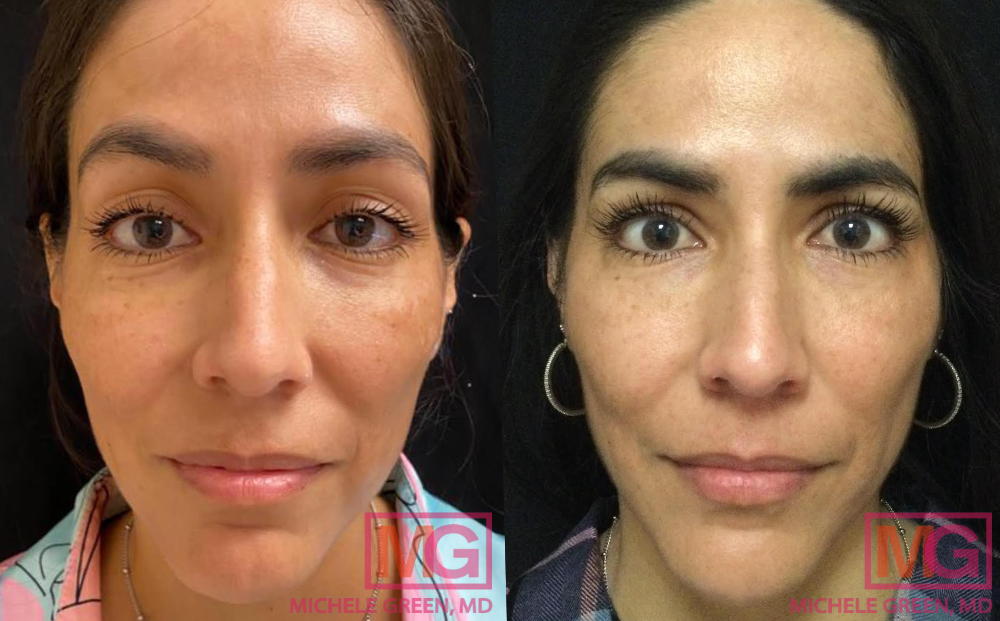
Before/After photo: Juvederm Voluma for cheeks and Restylane under eyes – 2 months
Are cheek implants safe?
Many patients considering cheek augmentation surgery worry about its safety and ask, “Are cheek implants dangerous?” Cheek implants are generally a safe cosmetic procedure for adding permanent volume, definition, and contour to the cheeks and midface. However, because the procedure is surgical, there is an increased risk of side effects and undesired cosmetic outcomes. Some of these risks include bleeding, asymmetry, scarring, improper healing, infection, deep vein thrombosis, coronary issues, implant migration, blindness, lumpiness, swelling, and ongoing pain. Before any surgery, it is important to weigh the risks and discuss them with your healthcare provider. Patients should consult a trusted plastic surgeon and follow all pre- and post-operative instructions to help minimize side effects and reduce the chances of unwanted results.
While cheek implants are effective for cheek augmentation, most patients prefer dermal fillers to avoid the risks of invasive plastic surgery, as dermal fillers involve little to no downtime or side effects. After dermal filler injections, patients may experience mild redness, swelling, or bruising that typically resolves shortly after treatment. Dr. Green consistently uses dermal fillers for cheek augmentation in her private NYC dermatology practice because they restore lost volume and enhance definition and contour. When you consult with Dr. Green, she will help you achieve safe, effective, and natural-looking cheek augmentation that lasts.
Can cheek implants be removed?
Cheek implants involve the permanent surgical placement of implants on or below the cheekbones (malar and submalar implants, respectively). However, they can be removed through another surgical procedure known as “revision cheek implant surgery.” While having a permanent cheek implant can offer advantages, if something goes wrong or the patient is unhappy with the appearance, removal or adjustment can be very difficult. Revision cheek implant surgery will require additional cost and downtime, along with the same risks as the initial surgery, including scarring, bleeding, infection, asymmetry, poor healing, pain, and permanent skin discoloration. Patients may choose to have their cheek implants removed if they experience asymmetry or implant migration, which can result in unnatural fullness along the eyelid, nose, or upper lip. Even after removal, patients may have loose skin that may need correction with an additional surgical skin-tightening procedure.
Are cheek implants worth it?
Before the advent of cosmetic dermal fillers and other non-invasive techniques, cheek implants (along with other facial implants, such as lip or chin implants) were more commonly used to shape facial contours and achieve a more youthful, long-lasting look. Surgical cheek augmentation with implants is an invasive procedure that typically requires local anesthesia and sedatives. Cheek implant surgery usually involves significant planning, cost, risk, and recovery time. For many patients seeking to add or restore facial volume, improve facial contours, and appear more youthful and refreshed, cheek implants may not be worth the trouble.
Many patients prefer dermal filler injections over cheek implants for cheek enhancement because of the treatment’s convenience and accessibility. Dermal fillers are a minimally invasive cosmetic procedure that involves less downtime and discomfort compared to surgical cheek augmentation. Additionally, dermal fillers can be adjusted over time as the patient’s needs and aesthetic goals change, making cheek enhancement a fully customizable experience.
Are cheek implants better than fillers?
Cheek implants and dermal fillers are effective procedures for cheek enhancement that add volume, definition, and a refined facial contour to the cheek area and midface. Each cosmetic option has specific advantages to consider when choosing the best for you. Cheek implants are permanently placed under the skin, either on top of the cheekbone (malar implants) or beneath it (submalar implants), to increase projection or replace volume loss in the midface. Dermal fillers are injected into the cheeks and midface to restore volume and improve definition. Some fillers provide immediate results after injection, while others need a series of treatments to achieve optimal cosmetic outcomes. Dermal fillers for cheek augmentation offer long-lasting results that typically endure from one to two years.
While the permanent, one-time nature of surgical cheek implants may seem like an advantage, the temporary aspect of dermal fillers allows Dr. Green to adjust to changing face shapes over time. Additionally, if a patient desires more or less filler, Dr. Green can easily make adjustments by either injecting more into the treatment area or dissolving the filler to start over. Conversely, surgical cheek implants cannot be easily modified once placed. Removing or shifting an implant requires another surgical procedure, which involves downtime and risks such as scarring and serious infection. Patients should also consider recovery time and associated risks when choosing between surgical cheek implants and dermal fillers. Surgical procedures generally involve significant downtime and higher risks of complications like scarring, bleeding, infection, and improper healing.
In contrast, dermal filler injections involve no downtime, and when performed by a skilled injector like Dr. Green, the risk of serious adverse events is very low. If you’re unsure whether to choose cheek implants or dermal fillers, schedule a consultation with Dr. Green, an expert injector. They can recommend the best combination of treatments to help you look and feel like the best version of yourself.
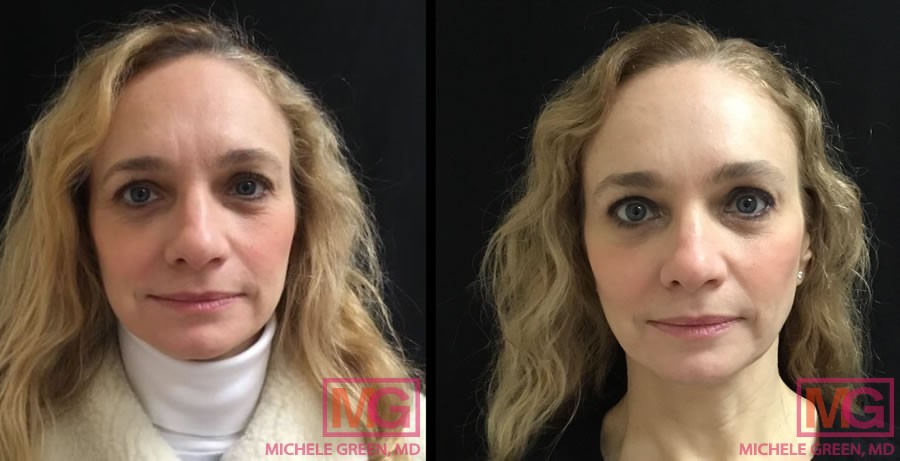
Voluma – Two weeks before and after
How to schedule a consultation for cheek augmentation in NYC today
Cheek augmentation procedures are very popular because they can address age-related volume loss, enhance facial contours, and give a more youthful appearance. Patients can choose surgical options like cheek implants or fat transfer, which offer permanent results. However, surgery often involves long recovery times, downtime, incisions, and higher risks of side effects. Many patients prefer dermal filler injections for cheek augmentation since they can restore facial volume and enhance contours with little or no downtime. An experienced injector, such as Dr. Michele Green in NYC, will tailor the treatment to your facial anatomy and aesthetic goals before choosing the right dermal filler for your cheeks. Whether your facial volume loss is due to aging or genetics affecting your cheekbones and midface, Dr. Michele Green in NYC is here to help.
Dr. Michele Green is a globally recognized, board-certified dermatologist with over 25 years of experience offering some of the world’s most selective individuals the finest non-invasive cosmetic treatments, including dermal fillers for cheek enhancement. She is consistently named one of the top dermatologists in New York by Castle Connolly, New York Magazine, Super Doctors, and The New York Times for her commitment to her patients and expertise. When you choose to work with Dr. Green, she will help you achieve a rejuvenated, natural appearance so you look and feel like the best version of yourself. She adopts a holistic, less-is-more approach to facial rejuvenation, tailoring each patient’s treatment plan to their unique needs and aesthetic goals. Dr. Green offers her patients from around the world the best cosmetic injectables for lip, chin, and cheek augmentation, as well as complete facial rejuvenation. To schedule a consultation with Dr. Green and learn more about cheek augmentation with dermal fillers, call the office at 212-535-3088 or contact us online today.
 212-535-3088
212-535-3088